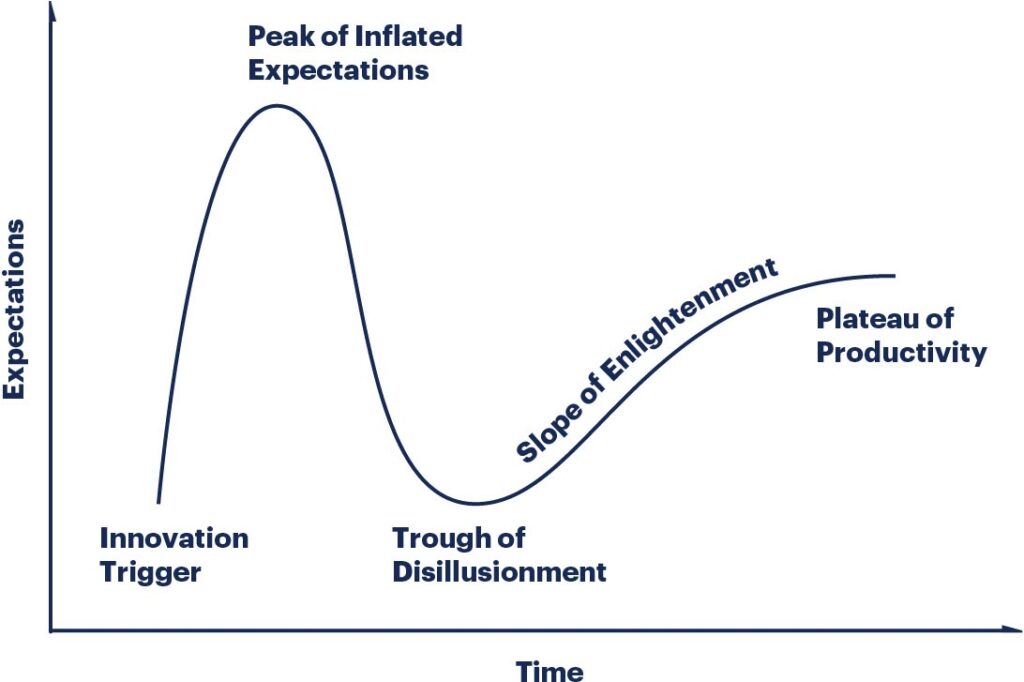 by Dan McNicholas, 4and20million co-founder
by Dan McNicholas, 4and20million co-founder
You may have come across the Gartner Hype Cycle before now. With one simple curve, it eloquently describes the phases of hype that accompany every new trend, gadget, big idea and lifestyle choice we experience. From a spark of inspiration or trigger of change, our expectations quickly rise to inflated levels as we put all our faith in this new concept to be lifechanging (hello, lockdown sourdough bakers!).

But what goes up must come down, and from the lofty heights of the Peak of Inflated Expectations, we inevitably descend into the Trough of Disillusionment, as we realise that our revelatory new discovery isn’t quite as lifechanging as we thought (RIP, podcasting career). After these two extremes we eventually climb back up the Slope of Enlightenment to a more balanced and realistic appraisal of the thing in question, settling at a steady and considered plateau.
In normal times, we’d currently be about to take our biennial dive down to the Trough of Disillusionment after watching England lose in a major tournament, having been elevated to the Peak of Inflated Expectation by a giddy tabloid press. Those who remember the annual cycle of Hen-mania followed by obituaries to British tennis over a two-week period every June will recognise the pattern of this emotional curve.
We can probably expect social-media-app-of-the-moment Tik Tok to tumble into the Trough of Disillusionment soon – somewhere, there is world-weary newspaper journalist or sub editor desperately looking for some unsuitable content or privacy concern to get enraged about (remember the Zoom hacking panic of mid-May?).
More interesting though is how this curve applies to the biggest factor in our working lives right now – remote working.
While very few of us really wanted to work totally from home before lockdown began, the initial reaction after a short period of adjustment was hugely positive. Yes, we may have struggled with kids being at home and not having all the tech set up, but as we got used to not going to the office, the wider narrative was about the upsides. No commute! Fewer overheads! Flexible working! We heard a lot over the course of April and May about companies moving to fully remote models, with eye-watering savings to be had by getting rid of office space.
“The end of the office? Coronavirus may change work forever” – Financial Times
“The notion of putting 7,000 people in a building may be a thing of the past” – Chief Exec, Barclays
“Slater and Gordon to close London office as remote working becomes norm” – Law Gazette
In recent weeks however, the narrative has started to shift as we peer down to the Trough of Disillusionment:
“Remote Work Is Stressing Lawyers Out” – Law.com
“One of the things I feel is, hey, maybe we are burning some of the social capital we built up in this phase where we are all working remote.” – CEO, Microsoft
“I miss an office. My company suffers from not having one. We have no culture. We rarely see each other as a group. We are not really a team, and lack bonding or social connections. We miss out on extemporaneously sharing ideas. Our innovation suffers. As a result, the value of my business suffers.” – Gene Marks, writing in The Guardian
While the benefits of not having to travel or iron were immediately clear, it has taken some time and reluctance to acknowledge the downsides. These include things we might be comfortable admitting to – like a lack of personal interaction and collaboration – and things we probably still don’t want to confess – the sizable challenge of self-motivation, productivity and trust in team members to pull their weight.
As we start to turn our attention to a potential return to the office, many of us will feel more keen to get back than we might have imagined a few weeks ago. The idea of permanently working from home will have lost much of its appeal as the novelty has worn off.
Nevertheless, we still have some way to go on our journey through the hype cycle. As we move past the Trough of Disillusionment, we will likely find a new perspective on work. While the dreams of an entirely remote workforce belong firmly in the Peak of Inflated Expectations for many companies and employees, a balance that allows the benefits of office and home working to co-exist will be feasible for many. This might mean more freedom to choose, with employees coming into the office when necessary to connect or collaborate and working remotely otherwise. It might mean abandoning a one-size-fits-all approach, with varying amounts of office time for different departments and specialisms, depending on need. It may involve more coffee shop catch ups, contact days, team bonding events and Results Only Work Environment policies.
Whatever the final reckoning, we’ve been given a unique and unlikely opportunity to thoroughly test the pros and cons of mass, prolonged remote working. When we do have more options of how, where and when to work, we will – for the first time – be in a position to make properly informed decisions based on real experience.
When we do reach it, the Plateau of Productivity won’t come without its challenges. We’ll need the right training, tech and processes to get the most out of whatever blended working arrangements are most suitable to our jobs. We’ll need to work hard to ensure that greater levels of remote working don’t hinder individual progression, and that we don’t create new disparities between office regulars and less frequent commuters. All of this will require careful consideration, time and effort. But it will be worth it. The Plateau of Productivity levels out much higher up the chart than when our hype journey started. This isn’t accidental. Genuine innovation (whether forced or spontaneous) always brings an opportunity for improvement. Once the hype runs its course, we can reach a new reality that is an improvement on the old one. This is the last challenge as we move through the Gartner hype cycle – to resist falling back into old ways and to ride the waves of positivity and criticism to find a better way than what we started with. We’ll never have a better opportunity to do so.
As a footnote to this article, it’s worth observing that our own motivation can match the rollercoaster of the hype cycle when we find ourselves in uncertain and threatening new territory. There’s naïve hope that this might soon be behind us, followed by despair and despondency that it won’t. After this comes a recalibration and adjustment to the new reality. This has been articulated brilliantly by Merete Wedell-Wedellsborg as a three-phase process of Emergency, Regression and Recovery, illustrated via Amy Cuddy below. The accompanying article in Harvard Business Review was written back in May, when we were still in the Emergency phase (https://hbr.org/2020/05/if-you-feel-like-youre-regressing-youre-not-alone). Today’s mid-June perspective is likely to be firmly in Regression.
Like the Slope of Enlightenment, the path to Recovery lies ahead.
